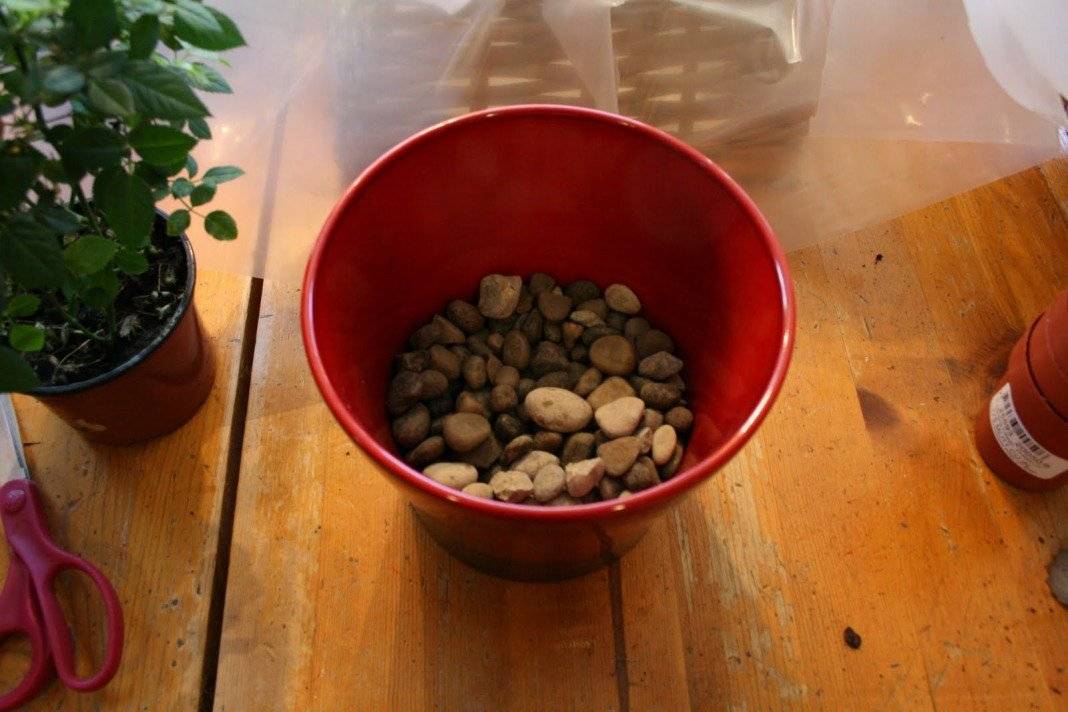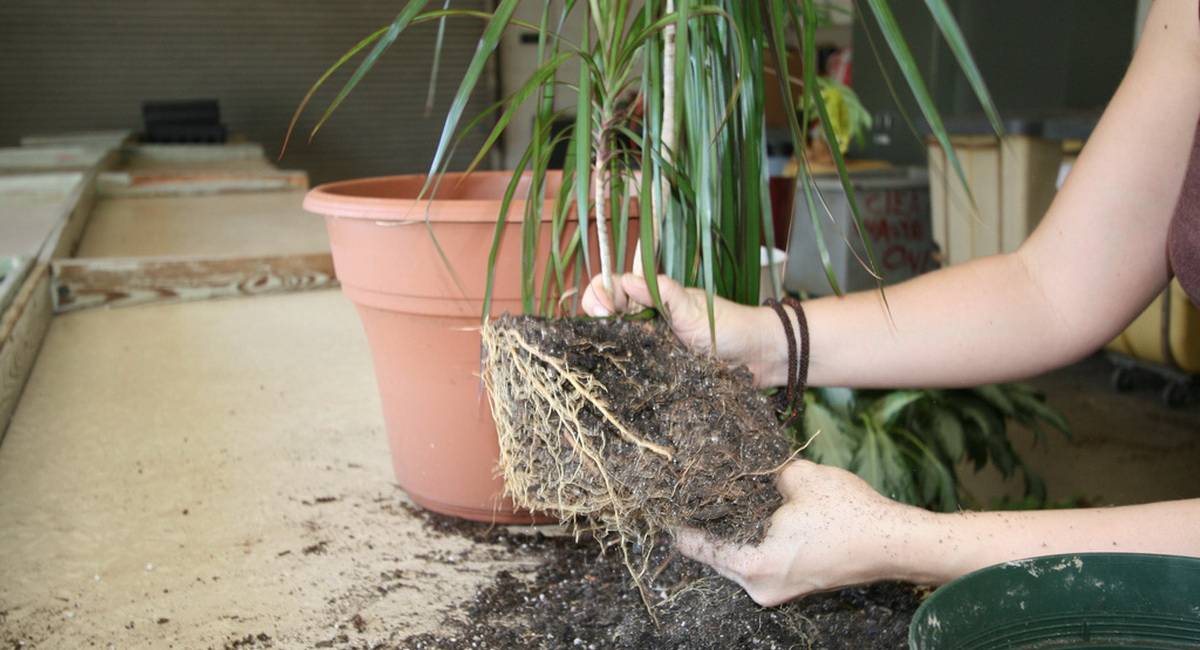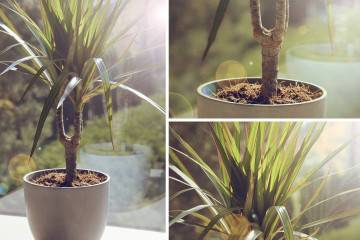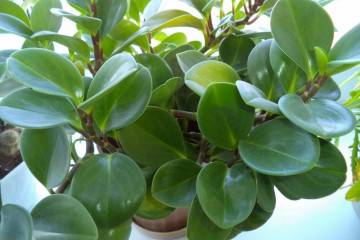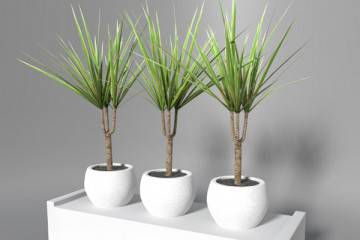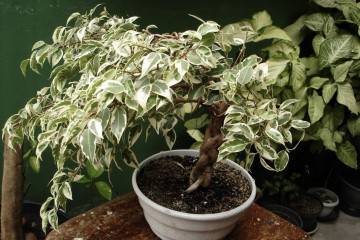Soil for Dracena - what is needed and how to choose
Content:
Dracaena is a tropical flower that is easily grown on a windowsill. Its root system develops quite quickly, every 1-2 years it needs to be transplanted into a new pot. In order for a plant to decorate a house or office for more than one year, you need to know in which land to plant the dracaena. You can purchase potting soil at a specialty store or prepare it yourself.
What kind of soil does dracaena like?
In general, dracaena is not capricious in terms of soil. The main thing is that it should be moderately acidic, allow moisture and air to pass through well, and contain nutrients.
Dracaena has long roots, so it is important to find the right flower pot for it. It should resemble a glass in shape - a tall container with a narrow bottom and wide top.
The plant does not like stagnant moisture, when transplanting, drainage of 3-4 cm is required. At the bottom of the pot there should be at least one, or preferably several, drainage holes. This is necessary to maintain the water balance at the proper level.
Expanded clay is suitable as drainage - baked clay pebbles with a diameter of 0.5-1 cm. You can also use vermiculite, small pebbles or ceramic chips.
What soil is needed for growing dracaena - general requirements:
- moderate looseness - the soil allows air to pass through well, but at the same time holds the plant;
- high water permeability - moisture should evenly flow to the roots without stagnation or drying out in certain places;
- rich mineral and organic composition;
- moderate acidity at 5.5-6 pH;
- lack of weeds, poisonous impurities, pests.
Essential ingredients and minerals
The soil for dracaena must necessarily contain potassium, magnesium, calcium. To do this, use double superphosphate (saturates with magnesium and calcium), as well as potassium sulfate.
In addition to the main components, additional additives are used. It can be charcoal, dolomite flour, humate. The complex combination of these substances makes the soil fibrous and nutritious, which is necessary for the full development of the plant.
As a fertilizer, you can use sapropel - an organic substance that is obtained from decomposed freshwater microorganisms. It saturates the substrate with acids and microelements, the fertilized plant takes root better.
What are all soil elements for?
Each substance performs a specific function in the composition of the soil:
- turf - the basis of soil for room dracaena;
- leafy ground - contains nutrients;
- biohumus - used as humus;
- sand - lightens the soil, improves air exchange;
- charcoal - enriches the soil with potassium, regulates acidity, increases looseness;
- peat - contains micronutrients, prevents soil hardening;
- humates - mineral substances that increase disease resistance;
- dolomite flour - saturates the substrate with potassium and calcium.
Choosing a land for dracaena
Knowing what kind of land is needed for dracaena, you can start choosing a soil mixture. From store formulations, land for palm trees is suitable. Substrates of TM "Sady Auriki", "Good", "Garden of Miracles" have proven themselves well in terms of price and quality.Purchased mixtures are sterile, include the necessary components, and save time. If it is not possible to buy ready-made soil, you can prepare it yourself.
What soils exist
Experienced gardeners divide the soil for dracaena into three types:
- an earthen mixture based on peat, turf, humus and sand. All components are mixed in a 1: 1: 1: 1 ratio;
- composition of leaf and sod land, sand, humus, peat in a ratio of 1: 1: 1: 1: 1;
- sand, leafy earth and turf in a ratio of 1: 1: 3, charcoal is added to the resulting mixture at the rate of 1 tbsp. l. For 2 liters of soil.
Preparation of soil constituents for dracaena
To prepare earth for dracaena at home, it is recommended to prepare all the components in advance. This is not a quick process.
Leafy soil is taken from under birch, walnut, maple. Together with the fallen leaves, remove 5 cm of the topsoil. A heap is formed from the extracted mixture, filled with nitrogen fertilizer and left for 2 years.
Sod land is taken from clover meadows or cereal fields. Layers of 20 × 25 cm (approximately) and 10 cm thick are dug out. They are placed on top of each other, poured over with liquid manure and left in a shady place for 2 years. The mixture must not be allowed to dry out, and over the summer the heap must be shoveled at least once.
It is advisable to take sand in a lake or river, followed by disinfection with potassium permanganate. As a last resort, coarse sand from the aquarium shop may do. Peat is also easier to buy at a flower shop.
Humus is prepared from manure and poultry droppings - everything should be overheated in a compost pit for 1-2 years. If it is not possible to make it yourself, you can replace it with purchased vermicompost.
Proper sterilization of the earth
The prepared earth for dracaena is disinfected. At home, the easiest way to sterilize it is in the oven. It is necessary to spread the soil on a baking sheet, stand for 10-15 minutes at a temperature of 200 degrees. Disinfection is best done 1-1.5 months before the intended transplant, so that the soil comes to life.
Major mistakes in soil preparation
A common mistake of flower growers is preparing soil with an excess of peat. It absorbs water intensively without recoil. And the plant is moisture-loving, so you need to observe the proportions, and do not forget about regular watering.
Some believe that a summer cottage is the best place to take soil. This is a misconception. The garden land is fertile, but it is distinguished by a high concentration of fertilizers and mineral salts. This is good for vegetables, but they can harm indoor flowers. Also in the garden soil there can be weeds, spores of pathogens, pest larvae.
Many people buy a ready-made mixture in a store and additionally enrich it with humus, dolomite flour, charcoal and other organic components. In general, this is not bad, but many unknowingly do not disinfect the substrate. This is fraught with the introduction of diseases and pests into the store soil.
What to do with the old land?
Dracaena is transplanted together with the old soil. You do not need to wash it out or shake it off - this is fraught with damage to the root system. Drainage is placed at the bottom of the new pot, and it is filled with prepared soil by about a third. A trunk is installed in the middle of the container, and the remaining earth is scattered on the sides.
The soil for dracaena should be loose so that the roots of the plant continuously receive moisture and fresh air. The substrate can either be purchased or made on your own. If the store does not have a composition specifically for dracaena, a mixture for palm trees is suitable.
